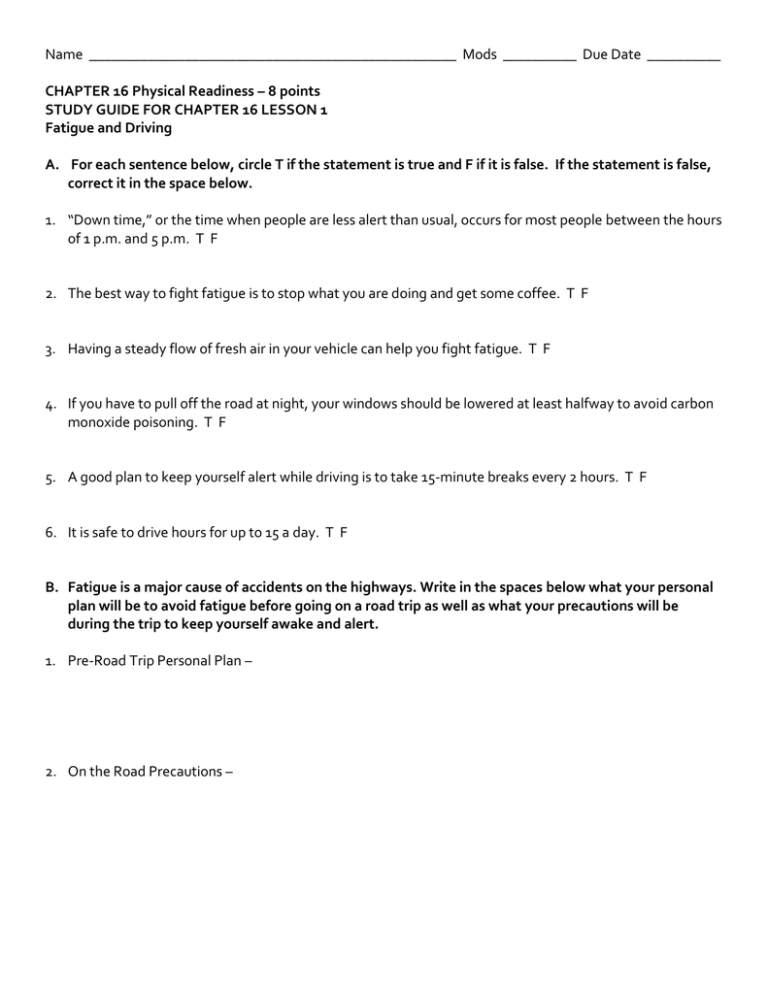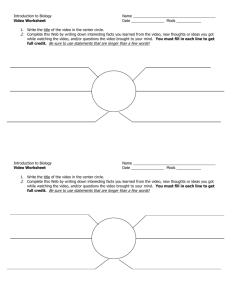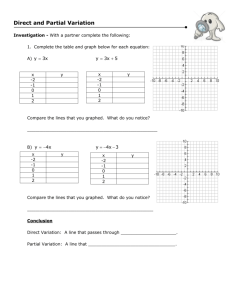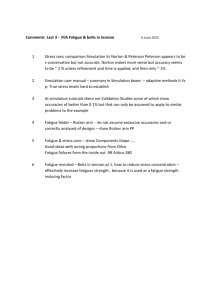Name Mods ______ Due Date ______ CHAPTER 16 Physical
advertisement

Name __________________________________________________ Mods __________ Due Date __________ CHAPTER 16 Physical Readiness – 8 points STUDY GUIDE FOR CHAPTER 16 LESSON 1 Fatigue and Driving A. For each sentence below, circle T if the statement is true and F if it is false. If the statement is false, correct it in the space below. 1. “Down time,” or the time when people are less alert than usual, occurs for most people between the hours of 1 p.m. and 5 p.m. T F 2. The best way to fight fatigue is to stop what you are doing and get some coffee. T F 3. Having a steady flow of fresh air in your vehicle can help you fight fatigue. T F 4. If you have to pull off the road at night, your windows should be lowered at least halfway to avoid carbon monoxide poisoning. T F 5. A good plan to keep yourself alert while driving is to take 15-minute breaks every 2 hours. T F 6. It is safe to drive hours for up to 15 a day. T F B. Fatigue is a major cause of accidents on the highways. Write in the spaces below what your personal plan will be to avoid fatigue before going on a road trip as well as what your precautions will be during the trip to keep yourself awake and alert. 1. Pre-Road Trip Personal Plan – 2. On the Road Precautions – Name __________________________________________________ Mods __________ Due Date __________ STUDY GUIDE FOR CHAPTER 16 LESSON 2 Short-Term Physical Conditions and Driving A. For each sentence below, circle T if the statement is true and F if it is false. If the statement is false, correct it in the space below. 1. You can drive after taking any medication prescribed by a doctor. T F 2. Temporary injuries can make it risky for you to drive. T F 3. Having the flu can affect the way you drive. T F 4. It is always safe to drive after taking over-the-counter medications. T F 5. The best defense against carbon monoxide poisoning is keeping your windows closed. T F B. If you must drive while you are ill or injured, list some ways in which you can compensate for your impaired condition. C. FIND OUT MORE. What if you had a cold and had to go on a trip? What kind of medication could you safely use? To find out, go to a local drugstore and look at the packages of cold remedies that they sell. Make a list of the ones that do not cause drowsiness. Name __________________________________________________ Mods __________ Due Date __________ STUDY GUIDE FOR CHAPTER 16 LESSON 3 Long-Term Physical Factors and Driving A. Many people who are physically challenged can now drive motor vehicles with the aid of certain improvements that have been made in technology and science. Some physical challenges are listed below. In the space next to each physical challenge, describe what can be used to make it possible for the person to drive. 1. People ‘without full use of their legs ________________________________________________________________ ________________________________________________________________ 2. People without arms ________________________________________________________________ ________________________________________________________________ 3. People who use wheelchairs ________________________________________________________________ ________________________________________________________________ 4. People who can’t turn their heads or shoulders ________________________________________________________________ ________________________________________________________________ B. For each sentence below, circle T if the statement is true and F if it is false. Correct each false statement in the space below. 1. A person with a spinal cord injury cannot get a license to drive. T F 2. Another term for an artificial limb is prosthetic device. T F 3. People between the ages of 50 and 75 have the highest pedestrian death rates. T F 4. Anybody with a physical challenge can now get a driver’s license. T F 5. An older person generally has a slightly faster reaction time than a younger person. T F C. FIND OUT MORE. Look online at the NJ Division of Motor Vehicles and find out what the procedure is for a physically challenged person to get a driver’s license in your state. 1. Are there different tests administered? 2. For what length of time are the licenses issued? 3. Are there different license plates?





